This article originally was published on March 1, 2017 at Law360.
Through the Enhanced Patent Quality Initiative, the U.S. Patent and Trademark Office is rolling out programs to enhance overall patent quality. The latest program rolled out was the Post-Prosecution Pilot (P3) Program, which was developed to enhance after-final practice.[1]
The P3 program combines features of the After Final Consideration Pilot (AFCP) 2.0 program and the Pre-Appeal Brief Conference Pilot (Pre-Appeal) program. The AFCP 2.0 requires a nonbroadening amendment, does not limit the types of arguments that can be made, and can result in an examiner interview. The Pre-Appeal program does not allow amendments, only allows certain types of arguments, and results in a formal review by a panel of examiners. The P3 program allows an optional nonbroadening amendment, does not limit the types of arguments that can be made, and requires an oral presentation in person, by phone, or by video conference before a panel of examiners, resulting in a written panel decision.
The P3 program began on July 11, 2016, and was slated to run for six months or when 1,600 P3 requests had been accepted into the pilot, whichever came first. The USPTO stopped accepting P3 requests as of Jan. 12, 2017, and indicated that the 200 request limit was reached in each particular technology center except for TC 1600 that had received 141 requests. The USPTO is now evaluating whether to renew the P3 program.
The authors filed a request under the Freedom of Information Act with the USPTO to obtain data on the P3 program. An initial analysis of the data shows some promising results.
Over the course of the P3 program, over 1,400 valid P3 requests were filed. One advantage of the P3 program is that a nonbroadening amendment is optional. The USPTO informed the authors that data on whether proposed amendments were filed with the P3 requests is unavailable, but the USPTO did provide information on whether a claim set was included with the P3 requests. However, a claim set provided in a response with a P3 request would not necessarily include amendments to the claims. Of the valid P3 requests filed, 31 percent were filed without a claim set and the remaining 69 percent were filed with a claim set. From a quick sampling on USPTO's Patent Application Information Retrieval[2] website, a high majority of valid P3 requests filed with a claim set did include amendments. Although claim set versus no claim set is not an exact equivalent for proposed amendments versus no proposed amendments, it appears to be a close approximation.
After a P3 request is accepted and the oral argument is presented, the P3 panel typically provides a decision either of an upholding of the previous rejection, or a decision of reopening prosecution. A panel decision of upholding the previous rejection may indicate that the proposed amendment would overcome the outstanding rejections, but allowability cannot be determined within the P3 program (e.g., it would take more time than allowed under the P3 program to determine allowability). A panel decision of reopening prosecution may be the result of a finding of error in the outstanding rejection. In some cases though, a panel decision may not be issued if the application is found allowable or if the applicant files an action (e.g., request for continuation (RCE), notice of appeal, etc.) prior to the issuing of the panel decision. Figure 1A shows the panel decision for valid P3 requests with a claim set and Figure 1B shows the panel decision for valid P3 requests without a claim set. This data does not include P3 requests for which a panel decision has not issued and a next action after the P3 request has not taken place (e.g., the panel is still deciding and an RCE or appeal has not been filed).
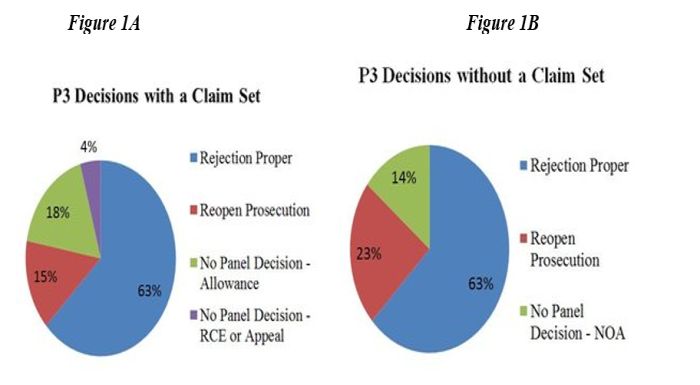
As can be seen in Figures 1A-B, the final rejection of record was found to be proper in about 63 percent of the applications regardless of whether a claim set was included or not. Reopening prosecution was 8 percent higher for P3 requests without a claim set and no panel decision with a notice of allowance (NOA) was 4 percent higher for P3 requests with a claim set.
The next action after filing a P3 request also provides insight into the results of the P3 program. The next action may be an action by the USPTO (e.g., nonfinal office action (NFOA), final office action (FOA), ex parte quayle action, notice of allowance) or an action or inaction by the applicant (e.g., notice of appeal, RCE, abandonment). For the valid P3 requests that have a next action after filing of the P3 request, 71 percent have a claim set and 29 percent do not. Figure 2A shows the next action after valid P3 requests with a claim set and Figure 2B shows the next action after valid P3 requests without a claim set. P3 requests were not included that do not have a next action as of yet (e.g., P3 panel has not made a decision or issued a notice of allowance, etc.).
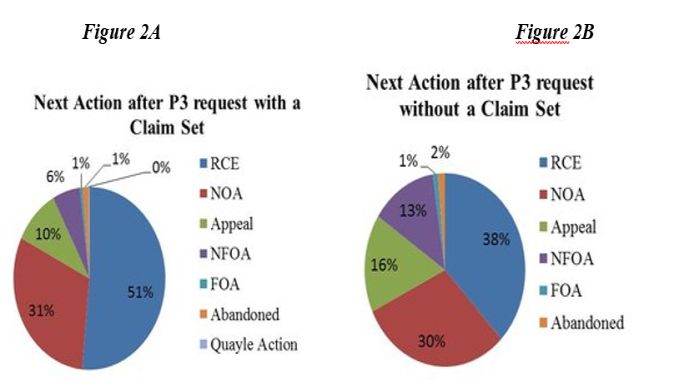
As can be seen in Figures 2A-B, the next action after a P3 request is a notice of allowance for about 30-31 percent of the applications regardless if a claim set was included or not. An NFOA or FOA was 7 percent higher for P3 requests without a claim set. An RCE, appeal, or abandonment was 7 percent higher for P3 requests with a claim set.
The types of next action after a P3 request are distributed throughout the different types of P3 panel decisions.
Of the valid P3 requests with a panel decision of upholding the previous rejection, 69 percent had a claim set and 31 percent did not have a claim set. Figure 3A shows the next action for a panel decision of upholding the previous rejection for valid P3 requests with a claim set and Figure 3B shows the next action for a panel decision of upholding the previous rejection for valid P3 requests without a claim set.
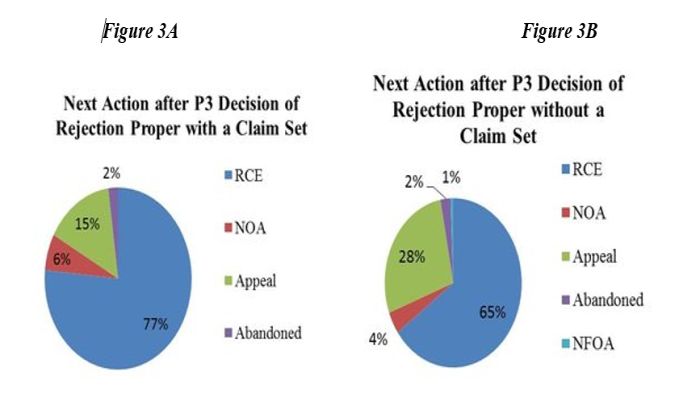
As would be expected, for the vast majority (92-93 percent) of P3 requests with a panel decision of upholding the previous rejection, the next action is an appeal or RCE. As can be seen in Figures 3A-B, for a panel decision of upholding the previous rejection, a notice of allowance was issued for about 4-6 percent of the applications. An RCE as a next action was 12% higher for applications with a claim set and an appeal was 13 percent higher for applications without a claim set.
Of the valid P3 requests with a panel decision of reopen prosecution, 56 percent had a claim set and 44 percent did not have a claim set. Figure 4A shows the next action for a panel decision of reopen prosecution for valid P3 requests with a claim set and Figure 4B shows the next action for a panel decision of reopen prosecution for valid P3 requests without a claim set.
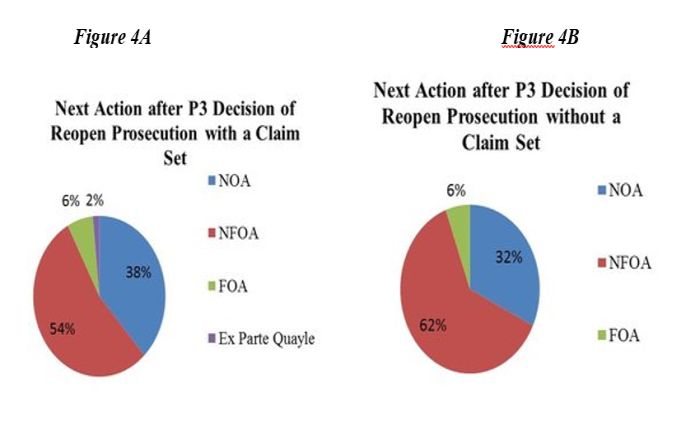
As can be seen in Figures 4A-B, for a panel decision of reopen prosecution, a next action of a notice of allowance or ex parte quayle was 8 percent higher for a P3 request with a claim set and an NFOA was 8 percent higher for a P3 request without a claim set.
Of the valid P3 requests without a panel decision as of yet, but a next action after the P3 request is present, 75 percent had a claim set and 24 percent did not have a claim set. Figure 5A shows the next action for no panel decision for valid P3 requests with a claim set and Figure 5B shows the next action for no panel decision for valid P3 requests without a claim set.
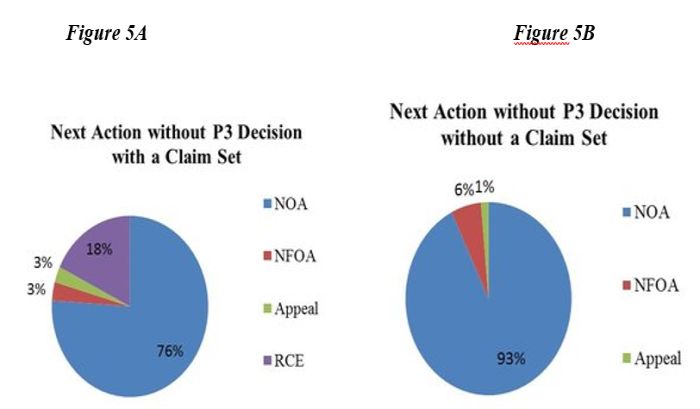
As can be seen in Figures 5A-B, for P3 requests with a next action without a panel decision, a next action of a notice of allowance was 17 percent higher for a P3 request without a claim set and an RCE or appeal was 20 percent higher for a P3 request with a claim set.
The above data seems to suggest that the P3 program has been beneficial for applicants. Of particular note is that about 30 percent of all valid P3 requests resulted in a notice of allowance (regardless of whether a claim set was included or not), and another 7-14 percent of all valid P3 requests resulted in reopening of prosecution with a new office action being issued (86 percent of which being a result of a panel decision of reopening prosecution). Also of note is that at least 31 percent of all P3 requests did not include amendments to the claims and nearly 69 percent of all P3 requests did contain proposed amendments.
Although a next action of allowance was not affected by inclusion of a claim set, valid P3 requests without a claim set were 7 percent less likely to have a next action of RCE or appeal and were 8 percent more likely to have a panel decision of reopening prosecution than valid P3 requests with a claim set. The results seem to support a conclusion that the P3 program has been effective in a significant number of cases at both addressing applicants' concerns about improper rejections of applications without having to resort to a lengthy and expensive appeal process in order to facilitate compact prosecution. Although the P3 program has had positive results, the above data also suggests that some improvements can be made to the P3 program. The Federal Register notice for the P3 program states the P3 program is "designed to reduce the number of appeals and issues to be taken up on appeal to the Patent Trial and Appeal Board (PTAB), and reduce the number of Requests for Continued Examination (RCE) and simplify the after final landscape."[3] Over 60 percent of all valid P3 requests result in a panel decision upholding the previous rejection. In the authors' experience with the P3 program, a majority of panel decisions upholding the previous rejection have indicated the proposed amendments submitted with the P3 request overcame all outstanding rejections, but prosecution was not reopened with a new office action being issued. Rather, applicants were forced to file a request for continued examination with an accompanying fee in order to have the amendments entered and have the examiner perform an updated search.
To better meet the P3 program's goal to reduce RCEs and appeals, it seems that the USPTO should revise the program to allow examiners more time to determine allowability. The examiners could be given extra time to perform an updated search, either in the P3 program or in reopened prosecution, in situations where the panel decides that the rejections have been overcome, similar to the extra time allotted to examiners with the AFCP 2.0 program to perform an update search on proposed amendments after final. It seems counter to the P3 objectives of reducing RCEs and appeals to require applicants to file an RCE where the P3 panel decides the amendments overcome all current rejections of record, in particular, in cases that would result in a second or subsequent RCE filing in an application for which the USPTO recently increased the filing fee to $1,700 for a large entity versus $1,200 for a first RCE. The above suggested change to the rules of the program would advance one of the intended purposes of the P3 program: that of reducing the need for applicants to file an RCE.
Hopefully, the P3 program will be renewed so that applicants can continue to enjoy the benefits of this program. To better meet the objectives of the P3 program, hopefully a revised P3 program will be implemented by the USPTO with changes to the rules that address stakeholder input.
The content of this article is intended to provide a general guide to the subject matter. Specialist advice should be sought about your specific circumstances.


